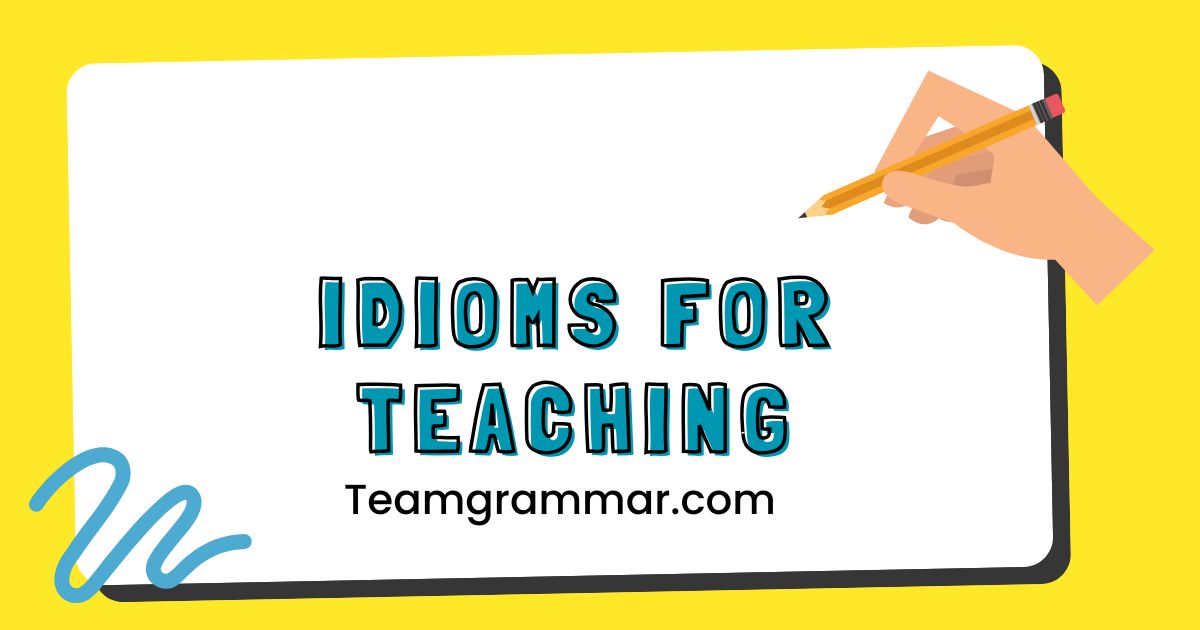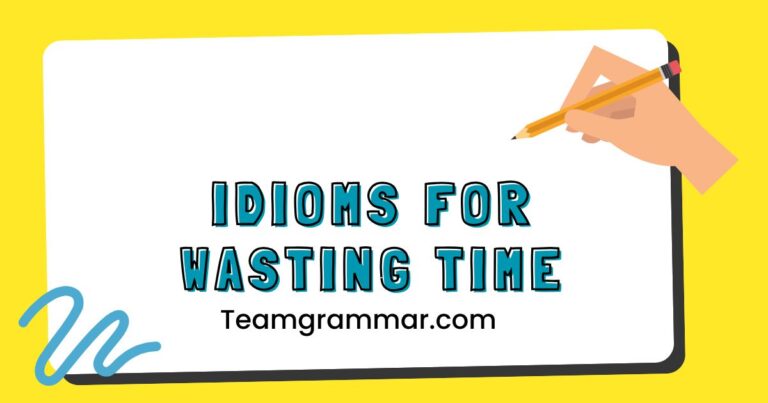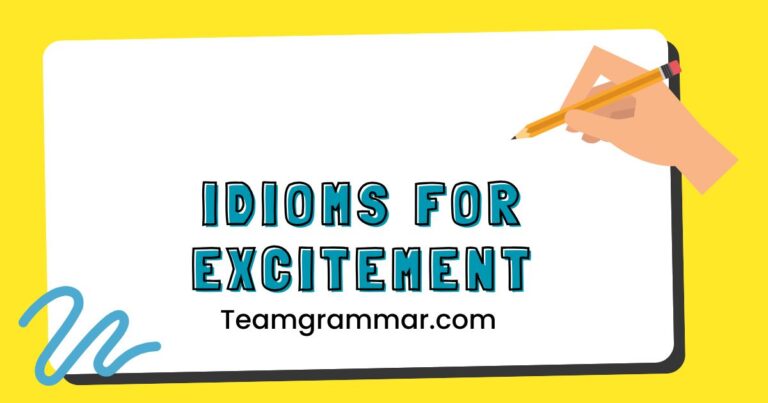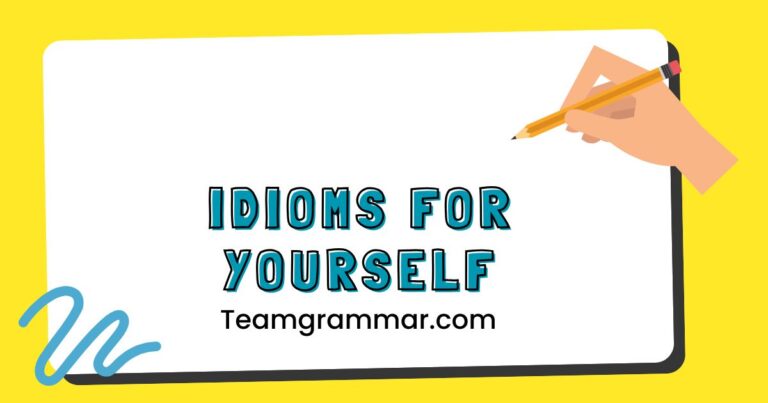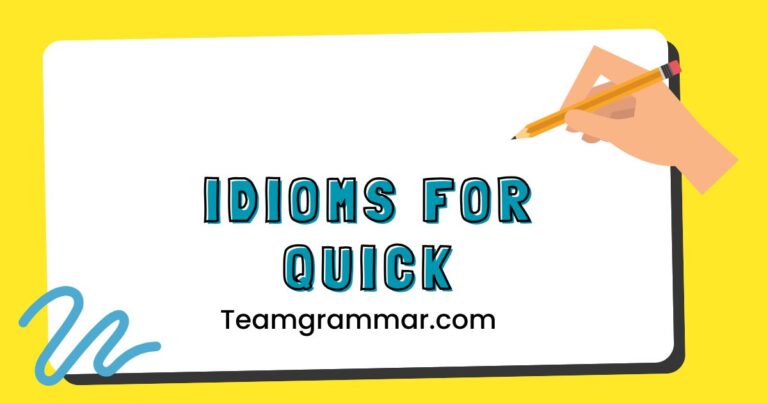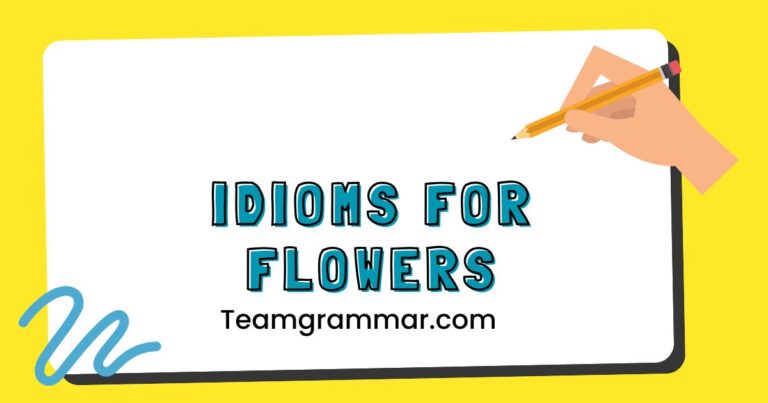41 Idioms for Teaching: A Comprehensive Guide
Understanding idioms is crucial for English language learners to grasp the nuances of everyday communication. Idioms, which are phrases whose meanings cannot be understood from the literal definitions of the words they contain, add color and depth to the English language.
For educators, mastering idioms is essential not only for personal fluency but also for effectively teaching and explaining these expressions to students. This article will delve into the world of idioms, providing a detailed guide for both teachers and learners, covering definitions, classifications, usage rules, common mistakes, and practical exercises to enhance comprehension and application.
Table of Contents
- Introduction
- Definition of Idioms
- Structural Breakdown of Idioms
- Types of Idioms
- Examples of Idioms
- Usage Rules for Idioms
- Common Mistakes with Idioms
- Practice Exercises
- Advanced Topics in Idioms
- FAQ About Idioms
- Conclusion
Definition of Idioms
An idiom is a phrase or expression whose meaning is different from the literal meaning of the individual words. Idioms are a fundamental part of any language, and mastering them is essential for achieving fluency and understanding native speakers.
They add color, expressiveness, and depth to communication. They are often culturally specific, reflecting the history and traditions of a particular language community.
Classification of Idioms
Idioms can be classified based on various criteria, including their structure, function, and the degree to which their meaning deviates from the literal meanings of their constituent words. Understanding these classifications can help learners better grasp the nuances of idiomatic expressions.
- Pure Idioms: These have no literal meaning. For example, “kick the bucket” (to die).
- Semi-Idioms: These have a literal meaning in some contexts, but a non-literal meaning in others. For example, “break a leg” (good luck).
- Literal Idioms: These are phrases where the literal meaning contributes to the overall idiomatic meaning. For example, “hit the nail on the head” (to be exactly right).
Function of Idioms
Idioms serve various functions in communication. They can be used to add emphasis, convey emotions, or simply make language more engaging.
Understanding the function of an idiom can help learners use it appropriately in different contexts.
- Emphasis: Idioms can add weight to a statement, making it more impactful.
- Emotional Expression: Idioms can convey feelings and attitudes in a vivid way.
- Engagement: Idioms can make language more interesting and relatable.
Contexts of Idioms
The context in which an idiom is used is crucial for understanding its meaning. The same idiom can have different connotations depending on the situation and the speakers involved.
Teachers need to emphasize this aspect when introducing idioms to students.
- Formal Contexts: Some idioms are more appropriate for formal settings, while others are better suited for informal conversations.
- Informal Contexts: Many idioms are commonly used in casual speech and writing.
- Cultural Contexts: Idioms are often tied to specific cultural references and may not be easily understood by those unfamiliar with the culture.
Structural Breakdown of Idioms
Understanding the structure of idioms can help learners recognize and use them more effectively. Idioms can be composed of various grammatical elements, including nouns, verbs, adjectives, and prepositions.
Analyzing these structures can provide insights into how idioms function within a sentence.
Common Idiomatic Structures
Idioms often follow specific structural patterns. Recognizing these patterns can help learners identify and interpret new idioms more easily.
- Verb + Preposition: Look up to (admire), get over (recover from)
- Verb + Adverb: Give up (quit), speak up (talk louder)
- Noun + Verb: Time flies (time passes quickly)
- Adjective + Noun: Blind alley (a situation with no solution)
Fixed Expressions
Many idioms are fixed expressions, meaning that their words cannot be changed without altering the meaning or making the idiom nonsensical. Teachers should emphasize the importance of using the correct wording when teaching idioms.
Example: “Hit the nail on the head” cannot be changed to “Strike the nail on the head” without losing its idiomatic meaning.
Figurative Language
Idioms often employ figurative language, such as metaphors, similes, and personification. Understanding these literary devices can help learners appreciate the richness and creativity of idiomatic expressions.
- Metaphor: Comparing two unlike things without using “like” or “as” (e.g., “a heart of gold”).
- Simile: Comparing two unlike things using “like” or “as” (e.g., “as cool as a cucumber”).
- Personification: Giving human qualities to non-human things (e.g., “time flies”).
Types of Idioms
Idioms can be categorized based on their thematic content, grammatical structure, or the type of figurative language they employ. Understanding these categories can help learners organize and remember different types of idiomatic expressions.
Animal Idioms
These idioms use animal names to convey specific meanings or characteristics.
Example: “Let the cat out of the bag” (reveal a secret).
Food Idioms
These idioms use food-related terms to express various ideas and emotions.
Example: “Piece of cake” (easy task).
Color Idioms
These idioms use colors to symbolize different feelings, situations, or qualities.
Example: “Feeling blue” (feeling sad).
Body Part Idioms
These idioms use body parts to describe actions, emotions, or states of being.
Example: “Keep an eye on” (watch carefully).
Examples of Idioms
Providing numerous examples is crucial for helping learners understand and remember idioms. The following tables offer a wide range of idiomatic expressions, categorized for easier learning.
Common English Idioms
This table lists some of the most frequently used idioms in everyday English.
| Idiom | Meaning | Example Sentence |
|---|---|---|
| Break a leg | Good luck | I heard you have a presentation today, so break a leg! |
| Piece of cake | Easy task | The exam was a piece of cake. |
| Hit the books | To study hard | I need to hit the books if I want to pass the test. |
| Let the cat out of the bag | Reveal a secret | She let the cat out of the bag about the surprise party. |
| Once in a blue moon | Rarely | I only go to that restaurant once in a blue moon. |
| Cost an arm and a leg | Very expensive | That car costs an arm and a leg. |
| See eye to eye | Agree | They don’t always see eye to eye on political issues. |
| Kill two birds with one stone | Accomplish two things at once | I can kill two birds with one stone by going to the bank and the grocery store in one trip. |
| Add insult to injury | Make a bad situation worse | To add insult to injury, it started raining after my car broke down. |
| Bite the bullet | To face a difficult situation with courage | I didn’t want to go to the dentist, but I had to bite the bullet. |
| Call it a day | To stop working on something | I’m tired, let’s call it a day. |
| Cut corners | To do something poorly to save money | The company cut corners on safety, which led to the accident. |
| Get something off your chest | To talk about something that has been bothering you | I need to get something off my chest. |
| In the same boat | In the same situation | We are all in the same boat when it comes to the economy. |
| Miss the boat | To miss an opportunity | If you don’t apply now, you’ll miss the boat. |
| On the ball | Alert and competent | She’s really on the ball when it comes to project management. |
| Pull someone’s leg | To joke with someone | Are you serious, or are you just pulling my leg? |
| Speak of the devil | The person you were just talking about arrives | Speak of the devil, here comes John now. |
| Take a rain check | Postpone a plan | I can’t make it tonight, but can I take a rain check? |
| Under the weather | Not feeling well | I’m feeling a bit under the weather today. |
| Back to square one | Having to start over | The experiment failed, so we’re back to square one. |
| Best of both worlds | Having all the advantages | Living in the countryside but working in the city is the best of both worlds. |
| Burning the candle at both ends | Working too hard | He’s been burning the candle at both ends lately. |
| Don’t count your chickens before they hatch | Don’t make plans based on something that might not happen | Let’s wait for the official results, don’t count your chickens before they hatch. |
| Every cloud has a silver lining | There’s something good in every bad situation | Even though you lost your job, remember every cloud has a silver lining. |
Idioms Related to Education
This table focuses on idioms that are commonly used in the context of education and learning.
| Idiom | Meaning | Example Sentence |
|---|---|---|
| Learn by heart | Memorize | You have to learn these vocabulary words by heart. |
| Pass with flying colors | Pass easily and with a high score | She passed the exam with flying colors. |
| Hit the books | Study hard | I need to hit the books if I want to do well on the test. |
| Burning the midnight oil | Studying late into the night | He’s been burning the midnight oil to finish his thesis. |
| Brain drain | Emigration of skilled workers | The country is experiencing a brain drain. |
| Teacher’s pet | Favorite student | He was always the teacher’s pet. |
| Cut class | Skip class | He decided to cut class and go to the beach. |
| Bookworm | Someone who loves to read | She’s such a bookworm; she always has her nose in a book. |
| Eager beaver | Someone who is very enthusiastic and hardworking | He’s an eager beaver when it comes to volunteering. |
| Know something inside out | Know something very well | She knows that subject inside out. |
| Old school | Traditional or outdated | His teaching methods are very old school. |
| Learn the ropes | Learn how to do something | It takes time to learn the ropes in a new job. |
| Straight A student | A student who gets excellent grades | She was a straight A student throughout high school. |
| Drop out | Quit school | He decided to drop out of college to start his own business. |
| Major in | Specialize in a subject | She’s majoring in biology. |
| Brush up on | Review or improve knowledge of something | I need to brush up on my Spanish before the trip. |
| Go the extra mile | Do more than what is expected | He always goes the extra mile for his students. |
| Show off | Boast or brag | He likes to show off his knowledge. |
| Skate by | Barely pass or succeed | He skated by in the class with a D. |
| Think outside the box | Think creatively | We need to think outside the box to solve this problem. |
| Ace a test | Get a perfect score | She aced the test without even studying. |
| Get the hang of something | Learn how to do something | It took a while, but I finally got the hang of it. |
| Play hooky | Skip school or work | They decided to play hooky and go to the amusement park. |
| Read between the lines | Understand the hidden meaning | You have to read between the lines to understand what he really means. |
| Take notes | Write down important information | It’s important to take notes during the lecture. |
Idioms Related to Work
This table provides idioms commonly used in the workplace.
| Idiom | Meaning | Example Sentence |
|---|---|---|
| Call the shots | Make the decisions | The boss calls the shots around here. |
| Get down to business | Start working seriously | Let’s get down to business and discuss the project. |
| Keep your eye on the ball | Stay focused | You need to keep your eye on the ball to succeed in this job. |
| Think on your feet | Make quick decisions | In this job, you have to be able to think on your feet. |
| Back to the drawing board | Start over | The project failed, so it’s back to the drawing board. |
| Corner the market | Dominate the market | They managed to corner the market with their innovative product. |
| Get the axe | Get fired | He got the axe after the company downsized. |
| Go the extra mile | Do more than expected | She always goes the extra mile to help her colleagues. |
| Hands are tied | Unable to act | My hands are tied; I can’t approve that request. |
| In hot water | In trouble | He’s in hot water with the boss after missing the deadline. |
| Jump the gun | Act too soon | He jumped the gun and announced the deal before it was finalized. |
| Keep your head above water | Manage to survive a difficult situation | It’s hard to keep your head above water with all these bills. |
| Level playing field | Fair situation | We need to create a level playing field for all competitors. |
| Make ends meet | Earn enough money to live | It’s hard to make ends meet in this economy. |
| Neck and neck | Close competition | The two companies are neck and neck in the market. |
| Out of the woods | Out of danger | The company is finally out of the woods after the financial crisis. |
| Put all your eggs in one basket | Risk everything on one thing | Don’t put all your eggs in one basket; diversify your investments. |
| Quiet as a mouse | Very quiet | She was as quiet as a mouse during the meeting. |
| Rock the boat | Cause trouble | He doesn’t want to rock the boat by questioning the boss’s decisions. |
| Sharp as a tack | Very intelligent | She’s as sharp as a tack and always comes up with great ideas. |
| Take the bull by the horns | Deal with a difficult situation directly | He decided to take the bull by the horns and confront the problem head-on. |
| Up in the air | Uncertain | The project’s future is still up in the air. |
| Value added | Extra benefit or advantage | The new feature provides significant value added to the product. |
| Win-win situation | Beneficial to both parties | The deal was a win-win situation for both companies. |
| Zero tolerance | No acceptance of something | The company has a zero tolerance policy for harassment. |
Usage Rules for Idioms
Using idioms correctly requires an understanding of their specific meanings and the contexts in which they are appropriate. Teachers must emphasize the importance of accuracy and relevance when teaching idioms.
Contextual Appropriateness
Idioms should be used in contexts where they are relevant and appropriate. Using an idiom in the wrong context can lead to confusion or miscommunication.
Example: “Break a leg” is appropriate before a performance but not during a serious business meeting.
Grammatical Correctness
Idioms should be used in grammatically correct sentences. The surrounding words should be appropriate for the idiomatic expression.
Example: Correct: “He kicked the bucket.” Incorrect: “He is kicking the bucketed.”
Cultural Sensitivity
Some idioms are culturally specific and may not be understood by people from different backgrounds. Teachers should be mindful of cultural differences when introducing idioms to students.
Avoiding Overuse
While idioms can add color and expressiveness to language, overuse can make speech sound unnatural or contrived. Teachers should encourage students to use idioms selectively and appropriately.
Common Mistakes with Idioms
Learners often make mistakes when using idioms due to their unfamiliarity with the expressions or their literal interpretation of the words. Addressing these common mistakes is essential for effective teaching.
Literal Interpretation
One of the most common mistakes is interpreting idioms literally, which can lead to nonsensical or incorrect meanings.
Correct: “It’s raining cats and dogs” (It’s raining heavily). Incorrect: “It’s raining cats and dogs” (Literal meaning of cats and dogs falling from the sky).
Misusing Words
Using the wrong words in an idiom can change its meaning or make it incomprehensible. It is important to use the exact words that make up the idiom.
Correct: “Hit the nail on the head.” Incorrect: “Strike the nail on the head.”
Incorrect Grammatical Structure
Using the wrong grammatical structure with an idiom can also lead to errors. The idiom must fit grammatically into the sentence.
Correct: “He is pulling my leg.” Incorrect: “He pull my leg.”
Using in Inappropriate Contexts
Using an idiom in the wrong context can lead to confusion or miscommunication. The context must be appropriate for the idiom’s meaning.
Correct: “Break a leg!” (Said to someone before a performance). Incorrect: “Break a leg!” (Said to someone who has just had an accident).
Practice Exercises
Practice exercises are essential for reinforcing learners’ understanding of idioms. The following exercises provide opportunities to apply the knowledge gained in this article.
Exercise 1: Matching Idioms with Meanings
Match each idiom with its correct meaning.
| Idiom | Meaning |
|---|---|
| 1. Piece of cake | A. Feeling sad |
| 2. Feeling blue | B. Good luck |
| 3. Break a leg | C. Easy task |
| 4. Hit the books | D. Rarely |
| 5. Once in a blue moon | E. Study hard |
Answers: 1-C, 2-A, 3-B, 4-E, 5-D
Exercise 2: Fill in the Blanks
Fill in the blanks with the correct idiom from the list: hit the books, let the cat out of the bag, cost an arm and a leg, see eye to eye, kill two birds with one stone.
- I need to ________ if I want to pass the exam.
- She ________ about the surprise party.
- That new car ________.
- We don’t always ________ on political issues.
- I can ________ by going to the store and the bank in one trip.
Answers: 1. hit the books, 2. let the cat out of the bag, 3. cost an arm and a leg, 4. see eye to eye, 5. kill two birds with one stone.
Exercise 3: Multiple Choice
Choose the correct meaning of the idiom in each sentence.
- He’s feeling under the weather today.
- He’s enjoying the good weather.
- He’s not feeling well.
- He’s working outdoors.
- The project is up in the air.
- The project is flying high.
- The project is uncertain.
- The project is finished.
- She’s burning the candle at both ends.
- She’s working too hard.
- She’s enjoying a relaxing evening.
- She’s wasting energy.
- They decided to call it a day.
- They decided to start working.
- They decided to continue working.
- They decided to stop working.
- He’s always on the ball.
- He’s always playing sports.
- He’s always alert and competent.
- He’s always distracted.
Answers: 1. b, 2. b, 3. a, 4. c, 5. b
Advanced Topics in Idioms
For advanced learners, exploring the nuances of idioms and their cultural contexts can deepen their understanding of the English language.
Regional Variations
Idioms can vary significantly from one region to another. Understanding these regional variations can enhance communication with native speakers from different areas.
Example: An idiom common in British English may not be understood in American English.
Historical Origins
Many idioms have historical origins that provide insights into their meanings. Exploring the etymology of idioms can enhance learners’ appreciation of the language.
Example: The idiom “raining cats and dogs” may have originated from a time when heavy rainstorms would wash animals into the streets.
Idioms in Literature
Authors often use idioms to add depth and color to their writing. Analyzing the use of idioms in literature can enhance learners’ understanding of literary techniques.
FAQ About Idioms
- What is the difference between an idiom and a proverb?
An idiom is a phrase whose meaning is different from the literal meaning of its words, whereas a proverb is a short, well-known saying that expresses a general truth or piece of advice. Idioms often focus on specific situations, while proverbs offer broader wisdom.
- How can I improve my understanding of idioms?
Read widely, listen to native speakers, and pay attention to the context in which idioms are used. Keep a notebook of new idioms and practice using them in your own speech and writing.
- Are idioms the same in all English-speaking countries?
No, idioms can vary significantly between different English-speaking countries. Some idioms are specific to certain regions or cultures.
- Is it okay to use idioms in formal writing?
It depends on the idiom and the context. Some idioms are appropriate for formal writing, while others are better suited for informal communication. Consider your audience and the tone of your writing.
- How can I teach idioms effectively to ESL students?
Provide clear definitions, use visual aids, give plenty of examples, and encourage students to practice using idioms in different contexts. Focus on the most common and useful idioms first.
- What are some common mistakes to avoid when using idioms?
Avoid interpreting idioms literally, misusing words, using incorrect grammatical structures, and using idioms in inappropriate contexts. Pay attention to the specific meaning and usage of each idiom.
- Why are idioms important for language learners?
Idioms are essential for understanding native speakers and achieving fluency in English. They add color, expressiveness, and depth to communication.
- Where can I find resources to learn more about idioms?
There are many online dictionaries, textbooks, and websites that provide information about idioms. Look for resources specifically designed for ESL learners.
- How do I know if an expression is an idiom or just a common phrase?
If the expression’s meaning cannot be understood from the literal definitions of its individual words, it is likely an idiom. Also, idioms often have a figurative or metaphorical meaning.
- Are there any strategies to remember idioms more easily?
Use mnemonic devices, create flashcards, and practice using idioms in real-life conversations. Associate idioms with visual images or personal experiences to make them more memorable.
Conclusion
Mastering idioms is an essential step towards achieving fluency and a deeper understanding of the English language. For educators, a strong grasp of idioms is vital for effective teaching and communication.
By understanding the definitions, classifications, usage rules, and common mistakes associated with idioms, both teachers and learners can enhance their ability to use these expressions accurately and appropriately. Regular practice and exposure to authentic English materials will further solidify this knowledge, enabling more meaningful and nuanced communication.
Remember to always consider the context and cultural implications when using idioms to ensure clear and effective communication.

